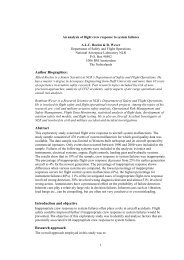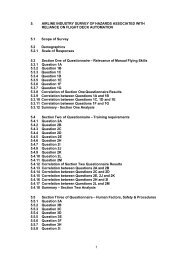Causal risk models of air transport - NLR-ATSI
Causal risk models of air transport - NLR-ATSI
Causal risk models of air transport - NLR-ATSI
You also want an ePaper? Increase the reach of your titles
YUMPU automatically turns print PDFs into web optimized ePapers that Google loves.
Table <strong>of</strong> contents<br />
List <strong>of</strong> abbreviations ................................................................................................. 4<br />
Chapter 1. Introduction............................................................................................ 7<br />
1.1. Research question.................................................................................... 9<br />
1.2. Scope....................................................................................................... 9<br />
1.3. Directions for the reader........................................................................ 11<br />
Chapter 2. Fundamentals <strong>of</strong> <strong>risk</strong>............................................................................ 12<br />
2.1. Definition <strong>of</strong> safety ............................................................................... 12<br />
2.2. Risk perception...................................................................................... 13<br />
2.3. Risk metrics........................................................................................... 14<br />
2.4. Risk criteria ........................................................................................... 17<br />
2.5. Theories about accident causation......................................................... 19<br />
2.6. Risk analysis and <strong>risk</strong> modelling........................................................... 20<br />
2.7. Conclusions for this section .................................................................. 21<br />
Chapter 3. Fundamentals <strong>of</strong> causation and probability.......................................... 23<br />
3.1. What is causation?................................................................................. 23<br />
3.2. Conditional independence..................................................................... 26<br />
3.3. Causation to predict the future .............................................................. 27<br />
3.4. Singular and generic causal relations.................................................... 28<br />
3.5. Strong and weak causal relations .......................................................... 29<br />
3.6. The beginning and the end <strong>of</strong> causation................................................ 29<br />
3.7. What is a causal model?........................................................................ 30<br />
3.8. Conclusions for this section .................................................................. 31<br />
Chapter 4. User needs............................................................................................ 33<br />
4.1. A brief history <strong>of</strong> aviation safety........................................................... 33<br />
4.2. Who are the users? ................................................................................ 43<br />
4.3. Perspectives on aviation safety ............................................................. 43<br />
4.3.1. Airlines.................................................................................................. 43<br />
4.3.2. Rep<strong>air</strong> stations....................................................................................... 45<br />
4.3.3. Aircraft manufacturer............................................................................ 47<br />
4.3.4. Air navigation service provider............................................................. 49<br />
4.3.5. Airports ................................................................................................. 51<br />
4.3.6. Policy makers and regulatory bodies .................................................... 52<br />
4.3.7. Passengers ............................................................................................. 58<br />
4.3.8. People living or working in the vicinity <strong>of</strong> <strong>air</strong>ports .............................. 60<br />
4.4. Summary <strong>of</strong> user requirements and discussion on consistency............. 62<br />
4.5. User expectations: lessons from CATS................................................. 72<br />
4.6. Conclusions for this section .................................................................. 74<br />
Chapter 5. Examples <strong>of</strong> aviation safety analyses................................................... 78<br />
5.1. Safety <strong>of</strong> mixed VFR/IFR <strong>air</strong> traffic at Geneva Airport ....................... 78<br />
5.2. Safety assessment <strong>of</strong> parallel approaches at Helsinki-Vantaa Airport.. 79<br />
5.3. Safety assessment <strong>of</strong> <strong>of</strong>fset steep approaches at Lugano Airport.......... 80<br />
5.4. Reduced vertical separation minimum in Europe ................................. 81<br />
5.5. VEMER ATM System increment 2002 ................................................ 83<br />
5.6. Conclusions for this section .................................................................. 84<br />
1




